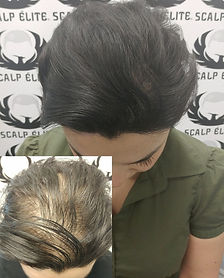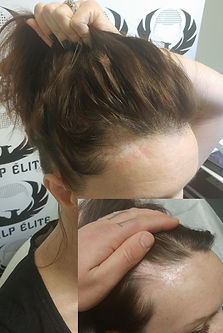
Aesthetic Clinic


Get back your confidence


People typically lose about 100 hairs a day. This usually doesn't cause noticeable thinning of scalp hair because new hair is growing in at the same time. Hair loss occurs when this cycle of hair growth and shedding is disrupted or when the hair follicle is destroyed and replaced with scar tissue.
Hair loss in men is so common that as many as 85% of all men will experience thinning or balding before the age of 50.
Hair loss is typically related to one or more of the following factors:
-
Family history (heredity). The most common cause of hair loss is a hereditary condition called male-pattern baldness or female-pattern baldness. It usually occurs gradually with aging and in predictable patterns — a receding hairline and bald spots in men and thinning hair in women.
-
Hormonal changes and medical conditions. A variety of conditions can cause permanent or temporary hair loss, including hormonal changes due to pregnancy, childbirth, menopause and thyroid problems. Medical conditions include alopecia areata, which causes patchy hair loss, scalp infections such as ringworm and a hair-pulling disorder called trichotillomania
-
Medications and supplements. Hair loss can be a side effect of certain drugs, such as those used for cancer, arthritis, depression, heart problems, gout, and high blood pressure.
-
Radiation therapy to the head. The hair may not grow back the same as it was before.
-
A very stressful event. Many people experience a general thinning of hair several months after a physical or emotional shock. This type of hair loss is temporary.
-
Certain hairstyles and treatments. Excessive hairstyling or hairstyles that pull your hair tight, such as pigtails or cornrows, can cause a type of hair loss called traction alopecia. Hot oil hair treatments and permanents can cause inflammation of hair follicles that leads to hair loss. If scarring occurs, hair loss could be permanent.
Risk factors
A number of factors can increase your risk of hair loss, including:
-
Family history of balding, in either of your parent's families
-
Age
-
Significant weight loss
-
Poor nutrition including protein and iron deficiencies
-
Certain medical conditions, such as diabetes and lupus
-
Stress
The Hamilton-Norwood Scale
Experts often refer to the Hamilton-Norwood Scale to help men understand the progression of male pattern baldness. This scale groups men’s hair loss into seven classes from the least amount of hair loss to the most.
Class I There is minimal or no recession of the hairline. At this stage, you should monitor your hair regularly for any signs of thinning.
Class II The initial signs of hair loss are becoming more visible. The hairline starts to recede, typically in symmetrical triangular shapes near the temples, like an “M” shape.
Class III There is deep symmetrical hair loss at the temples, which may be bare or sparsely covered with hair. At this stage, the hair also begins to thin at the crown.
Class IV Hair loss in the frontal region and at the temples becomes more severe. Additional thinning is visible near the hairline and thinning at the crown becomes more pronounced. A moderately thin band of hair separates the two areas of hair loss.
Class V There is still a visible separation between hair loss in the front and at the crown. However, the divide is becoming narrower. A “horseshoe” shape of remaining hair at the sides and back of the head is beginning to form.
Class VI More severe hair loss is clearly visible, as the hair separating the crown and the front temporal region is nearly gone with only sparse hair remaining.
Class VII This is the most severe form of hair loss. There is a complete loss of hair in the front, temporal and crown regions. The “horseshoe” shape of hair is all that remains, and the hair remaining may be less dense than it was previously.

The Ludwig Scale and Female Pattern Baldness
To help women better understand their hair loss, experts often refer to the Ludwig Classification Scale, which shows how female pattern baldness progresses. This scale separates women’s hair loss into three grades, or levels, based on severity.
Grade I This type of hair loss is characterized as minimal thinning. Hair loss at this stage can be so mild that it goes unnoticed. Typically, the hair becomes thinner in appearance, but the front hairline does not recede. However, those with Grade 1 hair loss will not experience a receding hairline.
Grade II At this moderate stage, women may notice decreased volume and a widening of their part. More of the scalp can become visible, and women may see an increase in hair shedding.
Grade III Often described as diffuse thinning, this grade of hair loss creates a see-through appearance on the top of the scalp. This is the most severe type of hair loss for women.



TYPES OF HAIR LOSS
ANDROGENETIC HAIR LOSS It is seen in both Men and Women but is more dramatic in Men. Thyroid disease, anemia, protein deficiency, chemotherapy, and low vitamin levels may cause hair loss.
Alopecia areata is an autoimmune condition where the immune system mistakenly attacks the hair follicles, causing hair loss on the scalp, face and other areas of the body. Alopecia areata can occur in multiple family members, suggesting genetics play a part in this condition. It affects both men and women and often first appears in childhood.
There are several forms of alopecia areata, including:
-
Alopecia areata (patchy hair loss) - This is the most common form of alopecia areata, resulting in one or more round patches of hair loss.
-
Alopecia totalis - This form of alopecia areata is characterized by the complete loss of scalp hair.
-
Alopecia Universalis - This condition is the most advanced form of alopecia areata and results in the total loss of hair on the scalp and body.
-
Ophiasis - This form of alopecia areata occurs in a wave pattern around the edge of the scalp, typically at the back of the head.
Involutional alopecia is the gradual thinning and loss of hair that comes with age. Over time, a greater number of hair follicles move into the resting phase and remaining hairs become shorter, finer and fewer in number. After androgenetic alopecia, aging is the second most common type of hair loss.
Traction Alopecia
Traction alopecia results from damaged hair follicles due to constant tension or pulling over a long period of time. Repeatedly wearing tight hairstyles, such as ponytails, buns or braids, can cause traction alopecia. This condition typically occurs near the temples or along the hairline. African-American women often experience this type of hair loss at their edges, which is the hairline area that goes from ear to ear and frames the face.
Chignon alopecia - This is a form of localized traction alopecia that results in hair loss at the crown of the head. Wearing hair in a tight bun over an extended period of time can cause chignon alopecia because of the way the style constantly pulls on the hair.
Cicatricial alopecia, also called scarring alopecia, refers to a group of rare disorders that destroy hair follicles and replace them with scar tissue. Most forms of the condition first appear as small patches of hair loss that may expand over time. Many African-American women suffer from this condition. While these disorders affect a small number of the population, they can result in permanent hair loss.
Central centrifugal cicatricial alopecia primarily occurs at the crown.
Hypotrichosis is a condition where there is no hair growth from the time of birth. Rather than having hair and losing it over time, people with hypotrichosis never grow any hair. This condition is thought to be caused by a genetic deviation during fetal development.
Trichotillomania is an impulse control disorder that drives individuals to compulsively pull out their own hair. Typically, trichotillomania results in patchy bald spots on the scalp, eyebrows and/or eyelashes.
Scalp folliculitis is usually due to a bacterial infection and occurs when hair follicles become inflamed due to blockage or damage. Follicles may be surrounded by a ring of inflammation and look like acne. In the early stages, hair may still be present in the follicle, but as the condition progresses, it will fall out. In severe cases, the inflammation can permanently damage hair follicles and result in hair loss.
Trichorrhexis nodosa is characterized by weak points, or nodes, present along the hair shaft. The nodes cause hair to break easily, leading to the appearance of thinning hair or patchy hair loss. The condition can be triggered by harsh styling practices such as the overuse of chemicals and heat styling tools. In some cases, trichorrhexis nodosa may be caused by underlying medical disorders such as thyroid problems, an iron deficiency or a buildup of ammonia in the body.
Contraindication for scalp micropigmentation:
-
Impetigo
-
Cold sore
-
Hives
-
Eczema
-
Psoriasis
-
Cellulitis
-
Basal cell carcinoma
-
Squamous cell carcinoma
-
Sunburn
-
Chemotherapy
-
Fever
-
Pregnancy